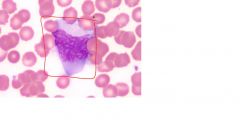![]()
![]()
![]()
Use LEFT and RIGHT arrow keys to navigate between flashcards;
Use UP and DOWN arrow keys to flip the card;
H to show hint;
A reads text to speech;
36 Cards in this Set
- Front
- Back
|
What CD is positive in hematopoietic stem cells?
|
CD34+
|
|
|
Draw a chart over the lineage of cells.
|

|
|
|
Normal WBC count is?
|
4000-10,000/μL (4.0-10 x 10^9/L)
|
|
|
Low WBC is called ____________, high WBC is called _____________.
|
leukopenia; leukocytosis
|
|
|
Neutropenia is clasically seen with _____________.
|
drug toxicity and severe infection (most neutrophils are out of blood and in the tissue)
|
|
|
Neutropenia could be treated with a ________ or a ________.
|
G-CSF; GM-CSF
|
|
|
Lymphopenia is classically seen in?
|
(1) Immunodeficiency (DiGeorge for example)
(2) High cortisol states (apoptosis) (3) Autoimmune destruction (lupus) (4) Whole body radiation |
|
|
The most sensitive cell in the human body to radiation are the _____________.
|
lymphocytes
|
|
|
What cell count would you look at to screen for radiation exposure in a patient?
|
Lymphocytes, looking for lymphopenia
|
|
|
What are causes of neutrophilic leukocytosis?
|
(1) Bacterial infection
(2) Tissue necrosis In these two, marrow will release slightly immature cells. This is called a left shift. (3) High cortisol state |
|
|
A man has an infection. Immature neutrophils are liberated into the blood. These immature cells are characterized by what? (In comparison to mature cells)
|
Decreased fc receptors
|
|
|
What is the marker for fc receptors?
|
CD16
|
|
|
High cortisol would ___________ (decrease/increase) neutrophils and ____________ (decrease/increase) lymphocytes.
|
increase neutrophils (from marginating pool); decrease lymphocytes
|
|
|
Cortisol decreases expression of adhesion receptors on ________.
|
neutrophils.
Produces neutrophilic leukocytosis. |
|
|
When could we see a monocytosis?
|
(1) Chronic inflammatory states
(2) Malignancy |
|
|
Eosinophilia is seen with?
|
(1) Allergic reactions
(2) Parasitic infections (3) Hodkin lymphoma |
|
|
The mechanism by which eosinophilia occurs in Hodkin lymphoma is increased _________.
|
IL-5
|
|
|
CML is the only leukemia with ______________.
|
thrombocytosis
|
|
|
Basophilia may be seen with?
|
CML
|
|
|
Lymphocytic leukocytosis is seen in?
|
(1) Viral infections
(2) Bordetella pertussis - Produces lymphocytosis promoting factor (LPF). It blocks lymphocytes from leaving the blood and entering the lymph nodes (they can't learn how to get stimulated to be able to fight infection). |
|
|
Infectious mononucleosis is an _______ infection (most commonly). Less common cause?
|
EBV
Less common is CMV. |
|
|
EBV infection results in what?
|
Lymphocytic leukocytosis comprised of reactive CD8+ T cells
|
|
|
EBV is transmitted via ________ and is classically seen in _________.
|
saliva; teenagers
|
|
|
EBV primarily infects ______, _______ and _______.
|
oropharynx; liver; B-cells
|
|
|
Which area of the lymph node will be enlarged in EBV infection?
|
Paracortex
|
|
|
What do we see clinically and on smear in EBV infection?
|
(1) Generalized LAD
(2) Splenomegaly (PALS) (3) High WBC count with atypical lymphocytes |
|
|
Regarding lymph nodes, the cortex is where the ____-cells live and the paracortex is where the ____-cells live.
|
B-cells; T-cells
|
|

What is it?
|
Atypical lymphocyte
|
|
|
Why is it called infectious mononucleosis?
|
Atypical lymphocytes look like monocytes. They thought it was monocytes.
|
|
|
How do you screen for mononucleosis?
|
Monospot testing.
|
|
|
Monospot test detects what?
|
IgM heterophile antibodies.
|
|
|
Why are IgM heterophile antibodies called heterophile?
|
They bind RBCs from another animal (hetero - other)
|
|
|
Monospot test usually turns positive within ____________ after infection.
|
1 week
|
|
|
Negative monospot test suggests what?
|
CMV as the cause
|
|
|
Definitive diagnosis of mononucleosis is made by?
|
Testing for EBV viral capsid antigen
|
|
|
Complications of infectious mononucleosis?
|

(1) Increased risk for splenic rupture (avoid all contact sports for the next year)
(2) Rash if exposed to penicillin (3) Dormancy of virus in B-cells (increases risk for recurrence of mononucleosis, risk for future lymphoma development especially in immunodeficiency) |

